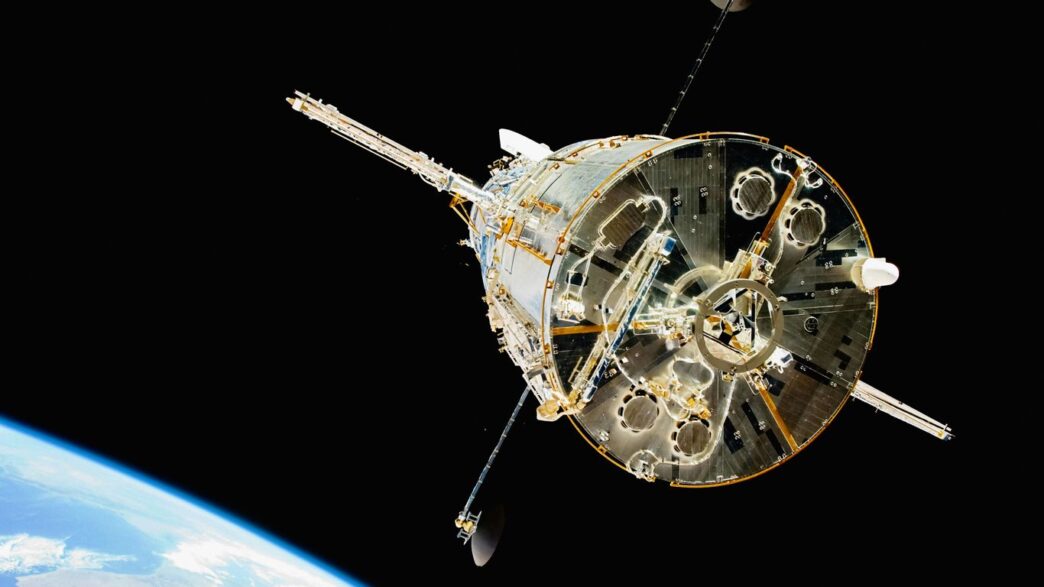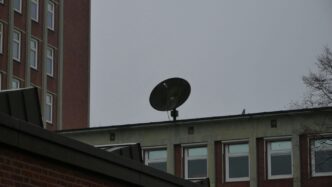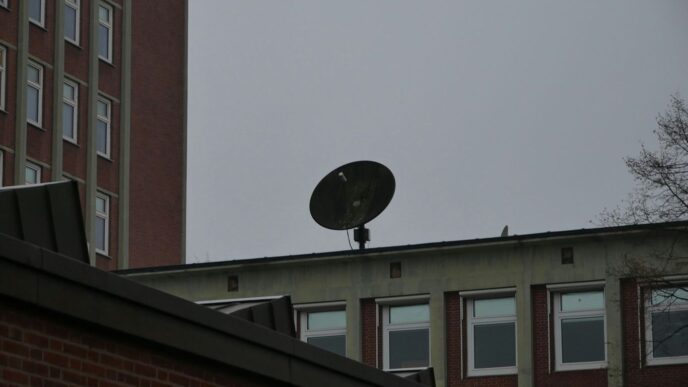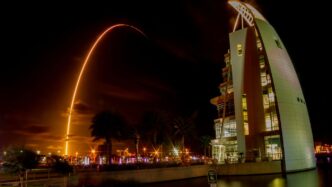Boeing Satellite Systems: Enabling Global Connectivity
Boeing’s work in satellite systems is really about connecting people and places, no matter where they are. They build satellites that do all sorts of things, from bringing internet to folks who don’t have it to helping scientists study our planet. It’s pretty amazing when you think about it – these machines orbiting way up high are making a big difference down here.
Powering Broadband and Entertainment
One of the biggest things Boeing satellites do is help with internet and TV. Think about those super-fast internet services you might have at home, or the channels you watch. A lot of that relies on satellites. Boeing is involved in projects like the O3b mPOWER constellation, which aims to give internet access to billions of people who currently can’t get it. They’re also working on satellites for services like ViaSat-3, which are designed to boost things like video streaming for homes and even for planes. It’s all about making sure more people can get online and enjoy entertainment.
Supporting Scientific and Environmental Missions
It’s not just about entertainment and internet, though. Satellites are also super important for science. Boeing builds spacecraft that help scientists keep an eye on our environment. This could be tracking weather patterns, monitoring climate change, or studying natural resources. These missions give us a better picture of what’s happening on Earth and help us make smarter decisions about how we take care of it. For example, satellites can help map out areas affected by natural disasters or track changes in forests over time.
Delivering Direct-to-Home Services
Remember when satellite TV was the big thing? Boeing has been a part of that for a long time. They build satellites that send signals directly to homes, giving people access to a wide range of channels and programming. This is especially important in areas where it’s hard to lay down cables for traditional TV services. It’s a way to bring entertainment and information right to people’s living rooms, no matter how remote they might be.
Advanced Satellite Platforms for Diverse Needs
Boeing builds a range of satellites to meet different communication needs. They have some really smart designs that can be updated even after they’re in space. This means they can adapt to new technologies or mission requirements without needing a whole new satellite. It’s pretty neat, actually.
The Flexible 702x Software-Defined Satellite
This is one of Boeing’s more adaptable satellites. Because it’s software-defined, its capabilities can be changed remotely. Think of it like updating the software on your phone to get new features – but for a giant satellite in orbit. This flexibility is great for all sorts of jobs, from providing internet to remote areas to supporting scientific research. It can be put into different orbits too, making it useful for a lot of different customers and missions.
Small Satellite Constellations with Millennium Space Systems
Boeing also works with Millennium Space Systems, a company they own, to create constellations of smaller satellites. Instead of one big, expensive satellite, they launch many smaller ones that work together. This approach can be more cost-effective and allows for more coverage. These smaller satellites are good for things like global internet access or tracking assets.
High-Power 702 Satellite Platforms
For missions that need a lot of power and capacity, Boeing has the 702 satellite platforms. These are big, powerful spacecraft designed for demanding tasks. For example, they are used for services like direct-to-home television and high-speed internet. They can also handle large amounts of data for commercial and government users. These satellites are built to last and provide reliable service for many years.
Strategic Communications for National Security
When it comes to national security, reliable and protected communication is absolutely key. It’s not just about talking; it’s about making sure that critical information gets through, no matter what. Boeing is playing a big part in this, working on systems that are designed to be tough and always available.
Evolved Strategic Satellite Communications (ESS) Program
This program is a pretty big deal. It’s all about updating the way the U.S. communicates for its nuclear command, control, and communications, or NC3. Think of it as a next-generation system that’s built to be more secure and dependable than what’s out there now. Boeing landed a significant contract for this, initially for two satellites with options for more. These satellites are meant to provide a protected communication link for the President and other high-level military operations. They’re designed to be resilient, meaning they can keep working even if someone tries to jam or disrupt the signal. It’s a complex system, and Boeing is working to make sure it’s ready for whatever comes next.
Modernizing Nuclear Command, Control, and Communications (NC3)
Updating the NC3 system is a massive undertaking. It involves a lot of different pieces, and the satellites are a big part of that. The ESS satellites are intended to eventually take over the role of older systems, like the Advanced Extremely High Frequency (AEHF) satellites. The goal is to have a more flexible and robust network. This isn’t just about having more capacity; it’s about making sure the communication lines are secure and can’t be easily compromised. The Space Force is working on the ground systems too, like the GRIFFON program, to make sure the whole network works together smoothly. It’s all about having a communication system that just works, every single time.
Resilient and Protected Satellite Architectures
Building satellites that can withstand a challenging environment is what this is all about. Boeing is using technology they’ve already developed and tested, like for their Wideband Global SATCOM satellites, and even on commercial systems. This means they’re not starting from scratch. They’re building on proven designs to create something that’s both advanced and low-risk. The idea is to have satellites that can provide constant coverage, even from high orbits, and use special signals that are hard to intercept or disrupt. It’s a serious effort to make sure that when the nation needs to communicate, especially in tough situations, those lines of communication stay open and secure. They’re scaling up production and investing in the right people to get these critical systems built and delivered.
Boeing’s Role in Critical Space Missions
When it comes to keeping our nation’s most important communications secure and always on, Boeing is a big player. They’re not just building satellites; they’re building the backbone for some really serious stuff, like making sure our leaders can talk to each other no matter what. It’s kind of like having a super-reliable phone line, but in space and way more complicated.
Supporting U.S. Space Force Initiatives
Boeing is working closely with the U.S. Space Force on some key projects. Think of it as a partnership to make sure our military has the best tools in orbit. They’ve got contracts to build new satellites that are tougher and smarter than older models. This means better communication for our forces, whether they’re on the ground, in the air, or out at sea.
Ensuring Always-Available Communication Capabilities
One of the main goals is to make sure communication lines are never cut. Boeing is developing systems designed to keep working even if there are attempts to jam or disrupt them. This is super important for national security. They’re building satellites that can handle a lot and keep talking, which is pretty much the definition of always-available.
Delivering Military-Grade Secure Solutions
When we talk about military communications, security is everything. Boeing builds its satellites with this in mind from the start. They use special technologies and designs to keep the information traveling through space private and protected. This isn’t just about scrambling a signal; it’s about creating a whole secure network that’s tough to break into. They’ve got a solid history of making these kinds of secure systems, which gives a lot of confidence to the folks who rely on them.
Collaborative Partnerships in Satellite Development

Building advanced satellites isn’t a solo act. Boeing really works with other companies to get these complex machines into space and doing their jobs. It’s like putting together a really complicated puzzle, and you need all the right pieces from different places.
Working with Viasat on Next-Generation Networks
Boeing and Viasat have teamed up on some pretty big projects. Think about the ViaSat-3 constellation – Boeing is building the actual satellite platforms, the 702 models, and Viasat is putting its own communication gear on them. This partnership is all about creating super-powerful satellites that can handle a ton of data, which is great for things like streaming video on airplanes or giving internet access to places that don’t have it now. They’ve worked together for a while, even helping each other out during satellite launches. It’s a good example of how two companies can combine their strengths to make something bigger and better.
Joint Efforts for Enhanced Satellite Services
It’s not just Viasat. Boeing also works with companies like SES. They built two C-band satellites for SES, called SES 20 and SES 21. These satellites are important because they help free up radio frequencies that can be used for new 5G mobile networks. So, while Boeing is building the hardware, they’re also helping other companies provide new kinds of services. They also have their subsidiary, Millennium Space Systems, which is focused on smaller satellite constellations. This means they can build and launch many smaller satellites together, which is a different approach to providing communication services.
Leveraging Proven Heritage and Advanced Technology
When Boeing works with partners, they bring a lot of experience to the table. They’ve been building satellites, especially their 702 series, for a long time – over 60 of them have flown for different customers. This history means they know what works and what doesn’t. They also use advanced tech, like solar arrays from their own company, Spectrolab. This combination of a solid track record and new technology makes their partnerships strong. They can offer reliable satellite platforms that are also up-to-date with the latest advancements, making them attractive to companies looking for dependable space communication solutions.
Future of Space Communication with Boeing
Looking ahead, Boeing is really pushing the boundaries of what’s possible in space communication. They’re not just building satellites; they’re creating the infrastructure for a more connected world. This means bringing internet access to places that have been left behind and making sure communication stays strong, even in tough situations.
Expanding Internet Access to Underserved Regions
It’s pretty wild to think about how many people still don’t have reliable internet. Boeing is tackling this head-on with projects like the O3b mPOWER constellation. This isn’t just about a little bit of internet; it’s about providing high-performance data links to the ‘other three billion’ people who currently lack access. Imagine what that could mean for education, healthcare, and economic opportunities in those areas. It’s a massive undertaking, but it’s happening.
Enhancing Connectivity for Mobility and Transport
Whether you’re on a plane, a ship, or a high-value government transport, staying connected is becoming the norm. Boeing’s work with platforms like the ViaSat-3 satellites is key here. These aren’t your average satellites; they’re designed for serious bandwidth, supporting everything from in-flight entertainment for commercial airlines to critical communication for business jets and government operations. It’s about making sure that wherever you are, you can get the data you need.
Innovating for Evolving Threat Environments
This is where things get really serious. In national security, communication needs to be not just available, but also incredibly secure and resilient. Boeing is developing advanced systems, like those for the Evolved Strategic Satellite Communications (ESS) program. These satellites are built with protected waveforms and advanced technologies to withstand interference and ensure that critical command and control communications, including nuclear command and control (NC3), remain operational no matter what. They’re working on architectures that can handle threats we haven’t even fully imagined yet, which is pretty mind-boggling when you think about it.
Looking Ahead
So, what does all this mean for the future? Boeing isn’t just building satellites; they’re building the connections that keep our world running. From bringing internet to places that don’t have it, like with the O3b mPOWER project, to making sure our military has secure communication lines, they’re involved in some pretty big stuff. They’re also working on satellites that can be updated with new software, which is pretty neat – kind of like getting a new phone without having to buy a new one. It’s clear they’re focused on making space communication more reliable and flexible, whether it’s for everyday use or for national security. They’re definitely a company to watch as we move further into this connected age.












